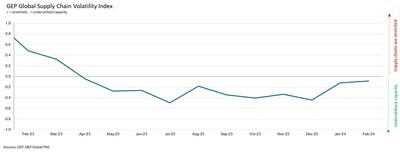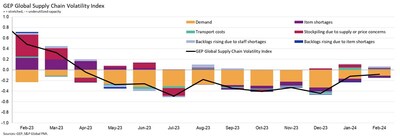- Input demand beginning to recover across all major markets, after a protracted nearly two-year period of decline
- North American suppliers see capacity stretched for the first time in nearly a year as manufacturers, especially in consumer-facing sectors, report growth
- Global transportation costs fall despite Red Sea disruptions
CLARK, N.J., March 14, 2024 /PRNewswire/ -- The GEP Global Supply Chain Volatility Index — a leading indicator tracking demand conditions, shortages, transportation costs, inventories and backlogs based on a monthly survey of 27,000 businesses — rose further in February. While global supplier capacity is still underutilized, the index increased to -0.08, from -0.12 in January, its highest in 10 months. After nearly a year of declining supplier activity, capacity pressures have begun building again.

Global demand for raw materials, commodities and components also showed signs of recovery in February after a nearly two-year period of decline due to destocking and high inflation. Input demand was stable in Asia, signaling restocking and economic resilience across the region. Similarly, evidence of inventory building in North America suggests the continent's manufacturers are preparing for growth. In fact, capacity at suppliers to North America was stretched for the first time since March 2023, with backlogs ticking higher as a consequence.
Notably, we continue to see evidence that the Red Sea attacks have had a negligible impact on global supply chains. The most visible effect was an uptick in transportation costs in January, but global logistics costs fell during February.
"Globally in February, we saw supply chains being more utilized, suppliers are busier, and input demand and manufacturing are turning a corner after nearly a year of low-capacity utilization," explained Mukund Acharya, vice president, consulting, GEP. "Suppliers to North America were the busiest globally last month, spurred by the Inflation Reduction Act and Bipartisan Infrastructure Law driving economic activity in construction, semi-conductors, and renewables."
Interpreting the data:
- Index > 0, supply chain capacity is being stretched. The further above 0, the more stretched supply chains are.
- Index < 0, supply chain capacity is being underutilized. The further below 0, the more underutilized supply chains are.
FEBRUARY 2024 KEY FINDINGS
- DEMAND: Although global demand for raw materials, commodities and components was still weak by historical standards, the downturn cooled, with trends improving across all major markets.
- INVENTORIES: After reaching a seven-month high in January as the Suez Canal disruption led to an increase in safety stockpiling, reports of firms building inventory buffers to protect against shortages or price changes fell in February.
- MATERIAL SHORTAGES: Reports of item shortages remained among the lowest seen in four years.
- LABOR SHORTAGES: There was some further upward movement seen in the frequency at which global manufacturers were reporting shortages of staff. Albeit the highest in six months, reports of poor labor availability remained only just above historically typical levels.
- TRANSPORTATION: Global transportation costs decreased in February, indicating a reduced impact on global supply chains from the disruption to shipping through the Suez Canal.
REGIONAL SUPPLY CHAIN VOLATILITY
- NORTH AMERICA: Index rose to 0.17, from -0.33, its highest since January 2023, showing stretched supplier capacity as manufacturers are boosting inventories and preparing for near-term production growth.
- EUROPE: Index rose sharply again to -0.41, from -0.63. While this is a sizeable improvement, the continent is still experiencing economic stress. Factory purchasing activity in Europe remained depressed amid the ongoing recession in Germany's manufacturing industry, but recoveries in southern Europe supported the index's move higher.
- U.K.: Index hits 10-month high of -0.34, up from -0.62 previously. U.K. companies report a marked uplift in safety stockpiling activity due to Red Sea disruptions.
- ASIA: Index stabilizes at -0.02, falling slightly from 0.14 in January as sharp manufacturer purchasing growth in India is offset by weaker demand in Japan, Vietnam and Taiwan.
For more information, visit www.gep.com/volatility.
The next release of the GEP Global Supply Chain Volatility Index will be 8 a.m. ET, April 12, 2024.
About the GEP Global Supply Chain Volatility Index
The GEP Global Supply Chain Volatility Index is produced by S&P Global and GEP. It is derived from S&P Global's PMI® surveys, sent to companies in over 40 countries, totaling around 27,000 companies. The headline figure is a weighted sum of six sub-indices derived from PMI data, PMI Comments Trackers and PMI Commodity Price & Supply Indicators compiled by S&P Global.
- A value above 0 indicates that supply chain capacity is being stretched and supply chain volatility is increasing. The further above 0, the greater the extent to which capacity is being stretched.
- A value below 0 indicates that supply chain capacity is being underutilized, reducing supply chain volatility. The further below 0, the greater the extent to which capacity is being underutilized.
For more information about the methodology, click here.
Full historical data dating back to January 2005 is available for subscription. Please contact economics@spglobal.com.
About GEP:
GEP® delivers AI-powered procurement and supply chain solutions that help global enterprises become more agile and resilient, operate more efficiently and effectively, gain competitive advantage, boost profitability and increase shareholder value. Fresh thinking, innovative products, unrivaled domain expertise, smart, passionate people — this is how GEP SOFTWARE™, GEP STRATEGY™ and GEP MANAGED SERVICES™ together deliver procurement and supply chain solutions of unprecedented scale, power and effectiveness. Headquartered in Clark, New Jersey, GEP has offices and operations centers across Europe, Asia, Africa and the Americas. To learn more, visit www.gep.com.
About S&P Global: S&P Global (NYSE: SPGI) S&P Global provides essential intelligence. To learn more, visit https://www.spglobal.com
Media Contacts | |
Derek Creevey | Joe Hayes |
Director, Public Relations | Principal Economist |
GEP | S&P Global Market Intelligence |
Phone: +1 732-382-6565 | T: +44-1344-328-099 |
Email: derek.creevey@gep.com |


Photo - https://mma.prnewswire.com/media/2362139/gep_index.jpg
Photo - https://mma.prnewswire.com/media/2362138/gep_index_2.jpg
Logo - https://mma.prnewswire.com/media/518346/GEP_Logo.jpg







